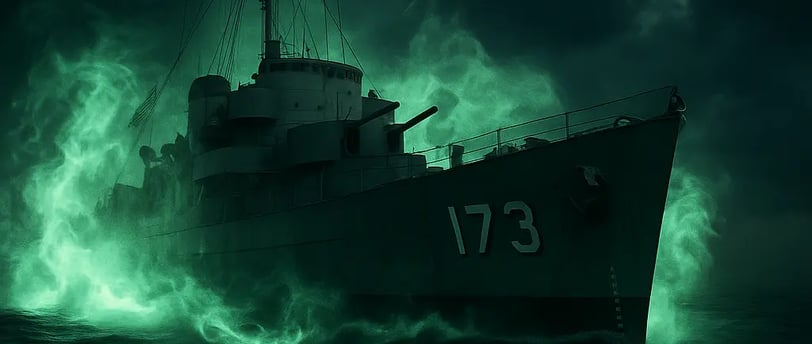The Philadelphia Experiment – What Really Happened in 1943?
Explore the mystery of the Philadelphia Experiment 1943—did the USS Eldridge vanish in a secret military test? Discover facts, theories, and the human stories behind this chilling legend.
HISTORICALLY AND TRULY UNEXPLAINED
Billys Zafeiridis
7/12/20256 min read


There’s a whisper that has floated through the years, caught between fact and fiction, between science and legend. It’s a story so strange, so unsettling, that even today it manages to creep into the corners of our curiosity. This is the tale of the Philadelphia Experiment — a naval military experiment shrouded in secrecy, alleged to have pushed the boundaries of reality itself back in 1943.
If you’ve ever felt that chill when hearing about strange phenomena — things that seem impossible yet refuse to be ignored — then this story will likely resonate with you. It’s not just about a ship, or science gone awry. It’s about the thin veil between what we think we understand and the mysteries lurking just beyond.
The Beginning of a Secret
During the height of World War II, the U.S. Navy was desperate for any edge that could help them win the war. Radar invisibility, silent ships — ideas that once seemed pure fantasy were suddenly the focus of serious research. According to legend, the Philadelphia Experiment was part of a project called "Project Rainbow," aimed at making the USS Eldridge, a naval destroyer escort, invisible to radar — and, supposedly, to the naked eye.
This wasn’t a simple cloaking device. The story goes much further: that the experiment bent light, magnetic fields, and even time itself — something far beyond what anyone at the time believed possible.
The project was supposedly top-secret, buried deep in classified files, with only a handful of people ever knowing the full truth. The very idea of bending space and time was something that blurred the line between science and the paranormal — and it seemed to touch on things humanity wasn’t yet ready to understand.
The Day the Ship Vanished
The fateful day came in October 1943. Eyewitnesses from the Philadelphia Naval Yard claimed to see the USS Eldridge suddenly enveloped in a strange greenish-blue glow before disappearing completely — only to reappear moments later hundreds of miles away in Norfolk, Virginia.
Some who watched said the ship didn’t just vanish; it seemed to phase out of this reality entirely. The descriptions of the light and the distortion that accompanied it were haunting — almost like the ship was slipping through the fabric of space itself.
The crew aboard reportedly experienced terrifying side effects. Some were said to have gone insane, others blinded or worse. There are chilling accounts of men physically fusing with the ship’s metal, trapped in a terrifying limbo between matter and nothingness.
If any of this is true, it raises the question: what had the Navy actually stumbled upon?
The Human Cost of the Experiment
Stories passed down claim the experiment left a trail of human tragedy. Sailors who survived told tales of confusion, pain, and psychological trauma so intense it shattered lives. Imagine coming back from a place where time and space no longer follow rules, where your body and mind can’t quite catch up.
Some reportedly vanished, others suffered chronic illnesses or mental breakdowns. A few were said to be locked in states of delirium, their minds caught in endless loops of fear and despair.
It’s here, in these human stories, that the legend finds its emotional core. Beyond the flashy science fiction ideas, there’s a deep, aching human toll — a reminder that some experiments might come at a cost too high to pay.
Theories and Explanations
Skeptics have long dismissed the Philadelphia Experiment as a hoax, a wartime myth inflated by misunderstandings and embellishments. After all, official Navy records deny any such event ever took place.
Yet, some researchers suggest the experiment was based on early electromagnetic research, involving radar waves and magnetic fields — areas that were rapidly developing during WWII. These technologies might have caused some strange effects, though nothing as dramatic as teleportation.
If you’re fascinated by electromagnetic theory or the fringe science surrounding invisibility and teleportation, a great place to start is diving into books that mix documented history with speculative science.
One recommended read is The Philadelphia Experiment: Project Invisibility — a book that carefully examines the facts and legends side by side.
Check it out on Amazon here.
Diving Deeper: What the Science Says
While mainstream science remains skeptical, there are intriguing areas of study related to the claims. Quantum physics, for example, touches on concepts of entanglement and the nature of reality that sometimes sound eerily similar to aspects of the Philadelphia story.
Electromagnetic fields can cause optical illusions and affect electronic instruments — but the idea of making a massive ship disappear, or warp time, is still beyond current technology.
It’s a reminder that our understanding of the universe is still evolving. Maybe one day, experiments like the Philadelphia one won’t seem so impossible.
The Legacy of the Philadelphia Experiment in Popular Culture
The Philadelphia Experiment has haunted the imaginations of storytellers and conspiracy theorists alike for decades. Movies, books, TV shows — many have drawn inspiration from this tale of invisibility, time travel, and the unexplained.
It’s fascinating how a story so rooted in mystery continues to resonate. Perhaps it’s because it taps into something universal — the desire to break free from our limits, to glimpse the impossible, and the fear of what might happen if we do.
If you’re drawn to this kind of storytelling, creating your own cozy reading nook or home library can turn these explorations into a ritual of wonder and curiosity. Personally, I swear by soft blankets and a warm cup of tea to make those late-night reads even more special.
Here’s a collection of cozy throw blankets perfect for reading nights.
The Psychological Impact: Why We’re Fascinated by the Unknown
What is it about the Philadelphia Experiment that grips us so deeply? Maybe it’s the fear of the unknown — a primal feeling that both terrifies and fascinates us. Stories like this force us to confront the idea that our reality might be just a thin layer over something stranger.
This kind of curiosity can be powerful, but it can also weigh heavily on the mind. That’s why balancing fascination with grounding practices — like mindfulness or journaling — can be helpful.
If you want a way to channel your thoughts and fears into something productive, journaling might be the answer. It helps organize scattered feelings and gives you a safe space to explore your imagination.
Find a beautifully crafted mindfulness journal here.
Exploring the Unknown Safely: Tools for the Curious Mind
Exploring spooky or mysterious topics can stir up intense emotions. To keep your mind clear and your spirit grounded, consider integrating some calming rituals.
Lighting scented candles, practicing deep breathing, or even doing gentle yoga can help center you after diving into heavy material. It’s like giving your mind a soft landing after a wild flight.
If you want to create a peaceful environment for your explorations, I recommend trying aromatherapy candles with calming scents like lavender or chamomile. They create an atmosphere that invites relaxation and presence.
Discover a variety of aromatherapy candles here.
How the Philadelphia Experiment Reflects Our Human Desire for Mystery
At its core, the Philadelphia Experiment story reveals something about us. We want to believe that there’s more to reality than what we see. That somewhere, hidden just out of reach, lies the door to something extraordinary.
Maybe that’s why the story has persisted — because it feeds our deepest hopes and fears. It’s a reminder that science isn’t just about equations and experiments; it’s about imagination, wonder, and sometimes, the very edges of belief.
If you want to deepen your connection to these themes, consider surrounding yourself with items that foster reflection — like inspiring books, beautiful notebooks, or even simple objects that carry meaning.
For example, a well-chosen book can transport you to other worlds or open your mind to new ideas.Check out some highly rated mystery and science fiction books here.
Closing Thoughts: The Philadelphia Experiment as a Mirror of Our Fears and Dreams
So what really happened in 1943? Did the USS Eldridge vanish? Was time and space bent by human hands? Or is it all an elaborate myth, a story born from the fears and hopes of a world at war?
The truth might never be fully known. But perhaps that’s the point. The Philadelphia Experiment isn’t just a story about a ship — it’s a story about us. About our endless curiosity, our desire to push boundaries, and the price we might pay when we do.
Thank you for joining me on this journey through one of history’s most compelling mysteries. I hope it’s sparked a bit of wonder, a little chill, and maybe a nudge to look at the world a bit differently.
And if you want to support this site and your own journey into mystery and paranormal, check out the products I’ve linked — they’ve helped me stay grounded and inspired along the way.
